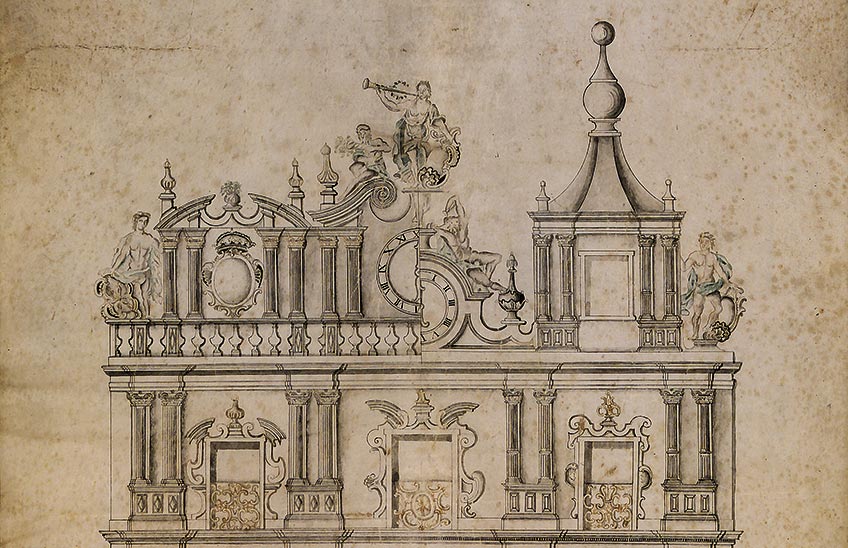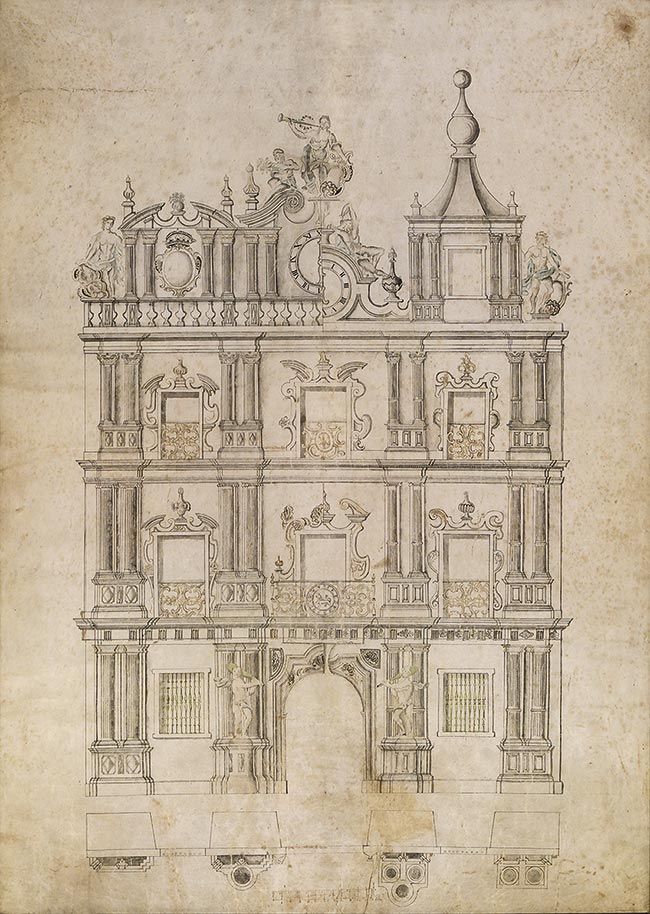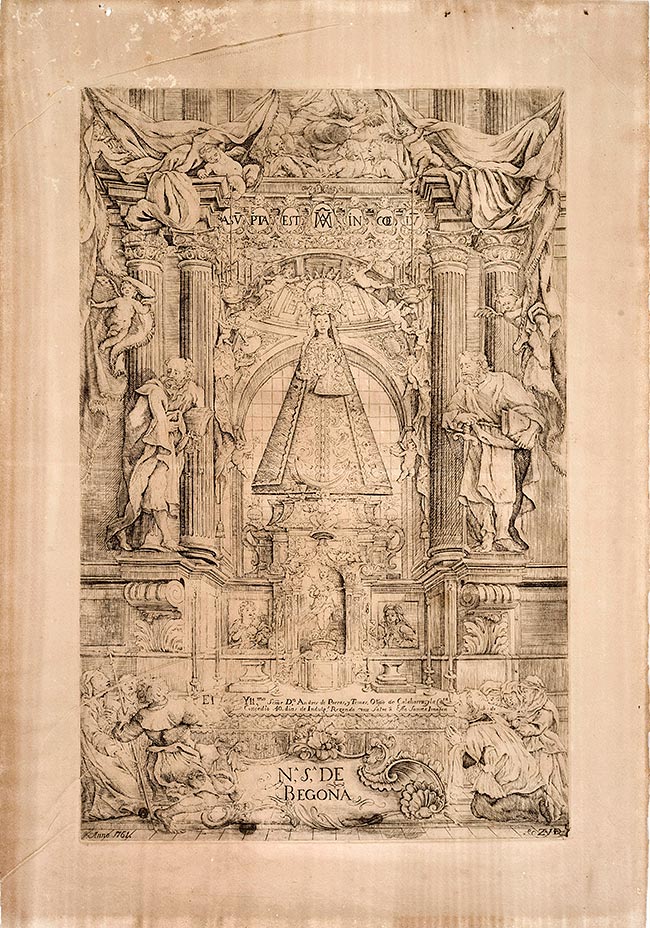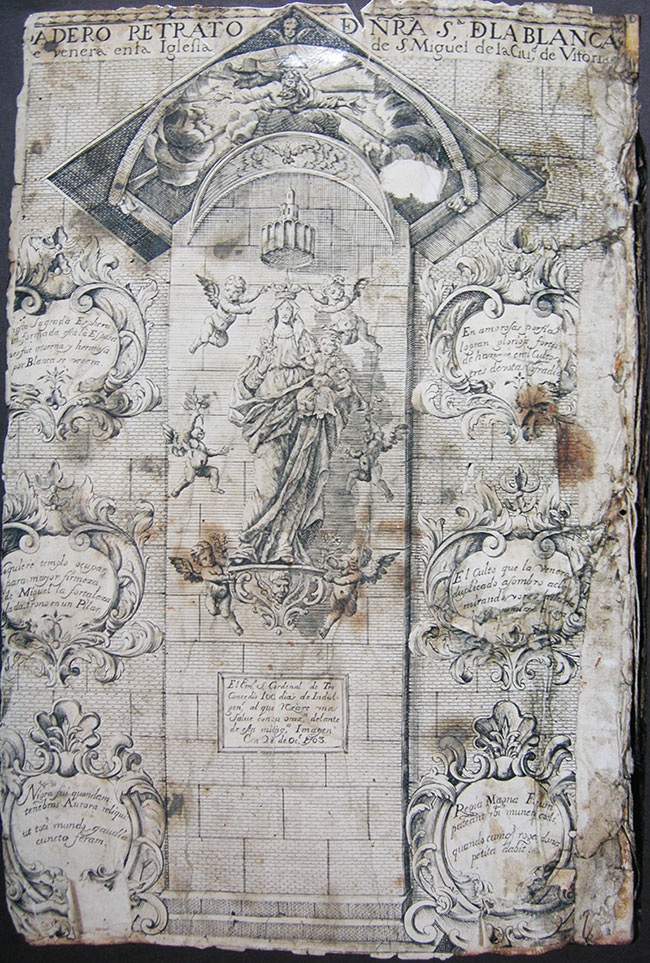José Zay Lorda: an enlightened man from Pamplona in the 18th century diaspora

Photoproject façade of Pamplona City Hall by José Zay Lorda, 1753. Photo file Municipal de Pamplona/
The destination of the Navarrese who devoted themselves to the arts in the 18th century was mainly Madrid, from those who wanted to learn to those who wanted to fill in their training. The Bourbon court and later the Royal Academy of San Fernando acted as catalysts for some, such as the painter Antonio González Ruiz (Corella), the sculptor Silvestre de Soria (Sesma) or the engraver Bernardo Albístur (Donamaría).
The presence in Bilbao of José Zay Lorda (c.1688-1779) from Pamplona, a cultured member of the clergy , an outstanding musician and chapel master of Santiago de Bilbao and an architectural enthusiast, was particularly extraordinary. The documentation of the city council of the capital of Navarre considers him to be "a native of this city" as well as "a person of singular skill and a rare idea for designing sumptuous buildings". He was the son of an assembler from Burguete, called Martín, who worked in Bilbao, becoming an examiner for his official document between 1710 and 1712. Don José sang mass in 1713 and in 1717 he asked the Bilbao town council to employ him in its official document as a musician, without success, which would not be a disastrous situation as he owned property and two chaplaincies in Navarre. In 1730 he again requested, in this case, the direction of the music chapel, which was granted.
He combined his work as a musician and architect. His work in Biscay included directing the construction of a bar in the port of Portugalete and the Punta Galea fort, as well as the layout of the Murguía church. He also acted as an expert appraiser for painting and town planning. The list of his possessions included a rich Library Services, with outstanding authors in different subjects and a large number of technical instruments, with various machines, a figure with its movements and even a device used to measure the steps walked throughout the day. All this makes him one of the most important figures in all fields of knowledge of the Age of Enlightenment in the Basque Country, A . His books on architecture, geometry, perspective, emblematics, mathematics, varnishes, agriculture, physics, medicine, liberal and mechanical arts, magic, Philosophy, jewellery, travel, applied and speculative sciences, present us, according to Carmen Rodríguez Suso, with a brave man who took the path of experimentation in the research in a context where the application of scientific knowledge was largely considered as sample of vanity, if not heresy.
His facet as an engraver has hardly been mentioned. It is possible that Portús and Vega refer to him in their discussion of clerics and friar engravers under the name of J. Zaytordes, whom they place in Bilbao in 1741. file An engraving of the White Virgin of Vitoria from 1721, made by the priest José Zaytorda or Zaitorda, which we have come across through Camino Urdiain, is kept in the Provincial Historical Archive of Álava. Its author can be none other than José Zay Lorda. The transcription of the slightly altered name was first made by Jesús de Izarra Retana in his monograph on the patron saint of Vitoria, using an untrimmed engraving in his possession.
Mañaricua and, more recently, Zorrozúa Santisteban published the 1761 engraving of the Virgin of Begoña in her old altarpiece designed by Pedro de la Torre, without identifying its author, who is none other than Don José Zaylorda, who signature with his first surname Zay, in a kind of monogram with the three letters interlaced, with the date 1761. This is what we have shown in our monograph on devotional prints in Navarre.
In this print he displays excellent resources and good technique. His fondness for intaglio prints can also be seen in some of his possessions, which include two half sheets of paper - probably drawings - with Saint Blaise and the Trinity and, more interestingly, "seven prints with their black frames and crystals made by the hands of the said Mr Zay Ylorda, which are Saint Joseph, Saint Anthony, Saint Barbara, the Magdalene, Saint Rose of Viterbo, the Conception and Saint Louis, Bishop of Toulouse". We are therefore dealing with an engraver who was probably self-taught and who should be rediscovered.
|
project Pamplona City Hall façade by José Zay Lorda, 1753. Photo file Municipal de Pamplona |
Leaving aside his facet as an engraver, it should be noted that he was asked for his opinions from the Navarrese capital at the time of such important works for the city as the town hall itself or the altarpiece of the Virgen del Camino in the parish church of San Saturnino. For the façade of the Town Hall he made a drawing in 1753 which, as Molins observes, presents two solutions on either side of the symmetrical axis. In 1755, one of them was chosen, which was judged to be of "greater magnificence and magnificence" than the one that had been contracted to Juan Miguel Goyeneta. The plan was basically followed, although the finial was replaced by a more classical solution, according to a drawing by Juan Lorenzo Catalán.
For the choice of the project to be followed in the altarpiece of the Virgen del Camino in San Saturnino de Pamplona in 1767, he made a report in which he judged the designs presented by three other masters, making acute observations about the model to be followed and the ability of the masters to carry out the work. He pointed out that it was necessary to be careful with the choice based only on the drawings, as "there are many who outline very well but in the execution they are poorly executed".
|
Engraving of the Virgin of Begoña by José Zay Lorda, 1761. Private collection. Photo José Luis Larrión |
Engraving of the Virgen Blanca de Vitoria by José Zay Lorda, 1721. file Photograph. Confraternity of the Virgen Blanca |
To find out more
FERNÁNDEZ GRACIA, R., El retablo barroco en Navarra, Pamplona, Government of Navarre, 2003.
FERNÁNDEZ GRACIA, R., Image and mentality. Los siglos del Barroco y la estampa devocional en Navarra, Madrid, Fundación Ramón Areces, 2017
MAÑARICUA, A. E., Santa María de Begoña en la historia espiritual de Vizcaya, Bilbao, publishing house Vizcaina, 1950.
MOLINS MUGUETA, J. L., "project para la fachada de la Casa Consistorial de Pamplona", Juan de Goyeneche y el triunfo de los navarros en la Monarquía Hispánica del siglo XVIII, Pamplona, Fundación Caja Navarra, 2005, pp. 282-283.
RODRÍGUEZ SUSO, C., "Sobre la training de un group de músicos ilustrados en el País Vasco Bilbao (1725-1740)", Revista de Musicología, 6 (1983), pp. 457-489.
RODRÍGUEZ SUSO, C., El board of trustees municipal de la música en Bilbao durante en Antiguo Régimen", Bidebarrieta. yearbook de Humanities y Ciencias Sociales de Bilbao, 3 (1998), Symposium Bilbao: 700 años de report. Bilbao a musical city. III, pp. 41-76
ZORROZUA SANTISTEBAN, J., El retablo barroco en Bizkaia, Bilbao, Diputación Foral de Bizkaia. department de Cultura, 1998.



